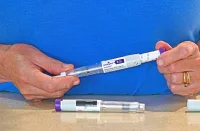As the popularity of weight loss drugs like Mounjaro, Ozempic, and Wegovy continues to rise, many users report eating less processed food and drinking less soda — a trend that’s already prompting food and beverage companies to rethink their marketing strategies. Originally developed for blood sugar control in diabetes, these drugs mimic a naturally occurring gut hormone that helps regulate appetite and slow digestion, often resulting in significant weight loss — clinical trials show reductions of 15% or more in body weight.
Between 2020 and 2022, GLP-1 use surged by 300%. By 2024, tens of thousands of new users were estimated to be starting these medications weekly, with research suggesting that roughly half of U.S. adults could qualify for a prescription. Currently, GLP-1s are approved for adults with a body mass index (BMI) of 30 or higher, or 27 or higher with a weight-related health condition like high blood pressure or type 2 diabetes.
A recent national study by the Arkansas Agricultural Experiment Station found that these glucagon-like peptide-1 agonists (GLP-1s) are driving noticeable changes in eating and drinking habits, influencing how food companies position their products. Food companies are starting to pivot. While pharmaceutical company stock prices have been climbing, many packaged food company stocks have taken a hit. Food manufacturers are now launching meals aimed specifically at GLP-1 users.
Although earlier research has shown GLP-1 medications help reduce cravings for high-fat foods and promote weight loss, there has been limited data on their broader impact on food preferences across categories.
Researchers surveyed current, former, and potential GLP-1 users — as well as non-users to better understand how the drugs influence eating patterns. The survey included 1,955 participants: 495 current GLP-1 users, 468 former users, 492 potential users, and 500 non-users.
The study found that both current and former GLP-1 users reported eating and drinking less of nearly every food category — especially processed foods, soda, refined grains, and beef. The proportion of respondents reporting less consumption of processed foods was approximately 70% more than of those who reported consuming more. Soda, refined grains, and beef saw reductions among about 50% more respondents.
Consumption of starchy vegetables, pork, alcohol, fruit juice, and dairy milk also declined, though to a lesser extent. Chicken, coffee, fish and seafood, nuts, eggs, plant-based meat, whole grains, and plant-based milk saw more modest decreases, with about 10-25% of users reporting reduced intake.
Even as consumption of many foods declined, cravings for items like processed foods, soda, refined grains, and beef persisted among GLP-1 users. Fruits, leafy greens, and water were the only categories where overall consumption increased.
These results suggest that GLP-1 use may increase consumption of healthier options like fruit and water, even if users still crave less healthy alternatives. Findings show that GLP-1 use changes not just how much people eat, but also what kinds of food they choose. That has major implications for the food industry. As GLP-1 adoption grows, food companies will face new challenges — particularly declining demand for processed foods — but also new opportunities, like increased demand for fruits and vegetables.
These findings could help inform marketing strategies, guide product development, and shape lifestyle recommendations for GLP-1 users. A follow-up study is underway to explore the side effects reported by those taking the medications.
Source: University of Arkansas System Division of Agriculture
Image Credit: iStock
References:
Dilley A et al. (2025) Characteristics and food consumption for current, previous, and potential consumers of GLP-1 s. Food Quality and Preference. 129:105507.










